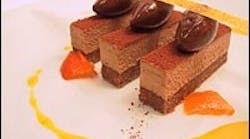It came as no surprise to gastronomes when the British magazine Restaurant named Heston Blumenthal's Fat Duck, in the London suburb of Bray in Berkshire, "the best restaurant in the world" last April. But many readers less familiar with Blumenthal's particular brand of culinary alchemy no doubt blanched when news reports rattled off some of the menu's most radical entries: snail porridge, sardine-on-toast sorbet, bacon-and-egg ice cream, carrot toffee and the like.
So is the Fat Duck's top ranking simply the height of snooty foodieism? Is proclaiming Blumenthal the world's foremost restaurateur the equivalent of an elitist music critic celebrating avant-garde composer John Cage's most difficult atonal compositions, or a contrarian art buff's embrace of the more esoteric works of Jasper Johns? If you've had a chance to sample Blumenthal's wares, or those of some of the other, edgier practitioners of what's now known as "molecular gastronomy," including Wylie Dufresne and Ferran Adria, the clear answer is "no way."While these chefs clearly have a flair for the dramatic and unexpected, they're by no means in the business of taunting patrons with foods that test the limits of the gag reflex. "Best in the world" isn't a title you achieve by plying only the bizarre. What these avant garde chefs are doing is fusing artistic inspiration with a keen grasp of the physical nature of ingredients. Approaching food with both a chemist's empiricism and an artist's instincts, they understand how and why certain ingredient combinations—even those that on first blush seem terribly ill-suited to one another—have the potential to produce something unprecedented and incredibly delicious.When I tasted one of Blumenthal's most celebrated — and counterintuitive — pairings some years back my initial resistance gave way to surprise. His white chocolate topped with a dollop of caviar brought, ultimately, delight when I realized what Blumenthal had known all along: the saltiness of the caviar would marry perfectly with the flavor profile and sweetness of the chocolate to produce a completely magnificent and unique taste experience.But let's be real. Mainstream packaged-foods manufacturers aren't in the business of shattering preconceptions or enlightening consumers. And even if the white chocolate-caviar combination scores big at places like the Fat Duck or Dufresne's WD-50 in New York, it's unlikely Hershey and Cadbury will slap a big yellow label on their next generation of products boasting, "Now with genuine sturgeon roe!"Innovators of Blumenthal's caliber call to mind the importance of pushing the envelope when searching for the next big product breakthrough. The language of "culinology," that hybrid description of food science and culinary art pioneered by the Research Chefs Association, has given chefs and R&D experts the common language they need to be able to communicate with one another more effectively than ever before.So today, if a chef finds that adding, say, star fruit to a canned stew yields a particularly pleasant sweetness and/or texture, he or she is now able to convey that fact to an R&D team. R&D experts, recognizing that including star fruit in stew isn't a viable option, can instead find ways to identify the particular elements of the star fruit responsible for the pleasing flavor and infuse those isolates into the product.Likewise, if Hershey and Cadbury determine that some of the flavor components found in caviar do something unique to their white chocolate, something they believe could resonate in a positive way with consumers, they could choose to zero in on the specific properties that seem to make the pairing work and reformulate a product accordingly.All of which is to say that, given American consumers' increasingly adventurous palates, manufacturers may want to consider expanding their vocabularies to encourage even the most wild-sounding experimentation. Seemingly bizarre combinations of ingredients have produced what many in the know consider to be the world's greatest restaurant. Isn't it conceivable that tinkering of a similar sort could be the key to the nation's next breakthrough snack cracker, frozen confection, soup mix or salad dressing?


